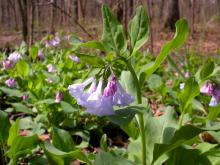Wildflowers, Grasses and Other Nonwoody Plants
Media

Species Types
Scientific Name
Erigenia bulbosa
Description
Heralding a new growing season, harbinger of spring can bloom as early as January in Missouri. You will probably have to look closely for its small clusters. But after a long winter, what a welcome sight they are!
Media

Species Types
Scientific Name
Geranium maculatum
Description
Called “crane’s bill” for its sharply pointed seed capsules, wild geranium is a gardening favorite, and there are cultivated varieties of this woodland wildflower bred for unique petal and leaf colors.
Media

Species Types
Scientific Name
Mertensia virginica
Description
One of our most stunning early spring wildflowers, bluebells is also a popular native plant for gardening. As with all native plant gardening, make sure you get your plants from ethical sources.
Media

Species Types
Scientific Name
Hibiscus lasiocarpos
Description
Hibiscus in Missouri? You bet! Hairy rose mallow is a native perennial whose 6-inch-wide blossoms look a lot like those of its tropical relatives. The stalks can get woody and can grow to 8 feet tall.
Media

Species Types
Scientific Name
Dicentra cucullaria
Description
Dutchman’s breeches, a common spring wildflower, is easy to identify. Note its bluish-green, fernlike leaves and its leafless stalks, from which dangle several white flowers shaped like old-fashioned knee breeches.
Media

Species Types
Scientific Name
Physostegia virginiana
Description
False dragonhead is called "obedient plant" because when you push one of the flowers sideways, it "obediently" stays in place for a while.
Media

Species Types
Scientific Name
Apocynum cannabinum
Description
Indian hemp is a shrubby, upright perennial with opposite branches and milky sap. This native plant can be a troublesome weed in crop fields and gardens, but Native Americans used its tough, fibrous stems for rope-making.
Media

Species Types
Scientific Name
Symphyotrichum pilosum (formerly Aster pilosus)
Description
White heath aster is one of Missouri's most widespread and weedy native asters. It grows in uplands, bottomlands, and nearly all habitats in between. It has a shrubby, wide-branching habit, and the stem leaves are thin and needlelike.
Media

Species Types
Scientific Name
Blephilia ciliata
Description
Square, unbranching stems, opposite leaves, two-lipped flowers, and a mild minty fragrance are clues Ohio horsemint is in the mint family. Tight, rounded flower clusters are stacked atop one another at the stem tips.
Media

Species Types
Scientific Name
Calystegia sepium (also Convolvulus sepium)
Description
Instantly recognizable as a type of morning glory, hedge bindweed is common in disturbed habitats and can be a serious agricultural weed, but it is not as problematic as its relative field bindweed.
See Also
About Wildflowers, Grasses and Other Nonwoody Plants in Missouri
A very simple way of thinking about the green world is to divide the vascular plants into two groups: woody and nonwoody (or herbaceous). But this is an artificial division; many plant families include some species that are woody and some that are not. The diversity of nonwoody vascular plants is staggering! Think of all the ferns, grasses, sedges, lilies, peas, sunflowers, nightshades, milkweeds, mustards, mints, and mallows — weeds and wildflowers — and many more!





















